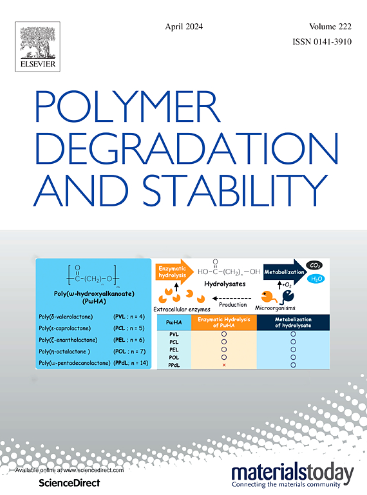Investigation of biodegradable microparticle release and environmental accumulation in Poly(butylene succinate) degradation under UV and non-UV aging conditions
IF 6.3
2区 化学
Q1 POLYMER SCIENCE
引用次数: 0
Abstract
This study investigates the release behavior of biodegradable microparticles and their environmental accumulation during the degradation of poly(butylene succinate) (PBS) through enzymatic hydrolysis and UV aging. By employing laser diffraction and image counting techniques, we monitored the real-time release of biodegradable microparticles during PBS degradation. The findings reveal that during enzymatic degradation, non-UV-aged PBS releases a significant number of microparticles, peaking at 4569 particles per 50 µL on the fifth day, with 97% of these particles subsequently degraded. In contrast, UV-aged PBS shows a markedly slower degradation rate. For samples pretreated with UV for 30 days, the number of released microparticles peaks at 1856 particles per 50 µL, and even after the complete disintegration of the primary material, approximately 52% of these microparticles remain undegraded. UV aging initially accelerated surface degradation due to photochemical reactions but ultimately reduced overall degradation efficiency by inducing crosslinking, resulting in persistent microparticle accumulation. Analytical techniques such as Scanning Electron Microscopy (SEM), Gel Permeation Chromatography (GPC), Nuclear Magnetic Resonance (1HNMR ), and X-ray Photoelectron Spectroscopy (XPS) were used to analyze structural changes and degradation products, revealing surface chemical transformations and their impact on microparticle release. This research underscores the importance of comprehensive environmental assessments of biodegradable plastics, particularly focusing on the dynamic release of microparticles during degradation. The findings provide a critical scientific basis for developing safer biodegradable materials and contribute to effectively addressing plastic pollution issues.
紫外光和非紫外光老化条件下聚丁二酸丁二烯降解过程中可生物降解微粒释放和环境累积的研究
本研究研究了生物降解微颗粒在酶解和紫外老化降解聚丁二酸丁二酸(PBS)过程中的释放行为及其在环境中的积累。通过激光衍射和图像计数技术,我们监测了PBS降解过程中可生物降解微粒的实时释放。研究结果表明,在酶解过程中,非紫外线老化的PBS释放出大量的微粒,在第五天达到峰值,每50µL 4569个微粒,其中97%的微粒随后被降解。相比之下,紫外线老化的PBS的降解速率明显较慢。对于用UV预处理30天的样品,每50µL释放的微粒数量达到1856个,即使在主要材料完全分解后,大约52%的这些微粒仍然未被降解。紫外线老化最初由于光化学反应加速了表面降解,但最终通过诱导交联降低了整体降解效率,导致持续的微粒积累。利用扫描电镜(SEM)、凝胶渗透色谱(GPC)、核磁共振(1HNMR)和x射线光电子能谱(XPS)等分析技术分析了结构变化和降解产物,揭示了表面化学转化及其对微粒释放的影响。本研究强调了对可生物降解塑料进行综合环境评估的重要性,特别是关注降解过程中微颗粒的动态释放。这些发现为开发更安全的可生物降解材料提供了重要的科学基础,并有助于有效解决塑料污染问题。
本文章由计算机程序翻译,如有差异,请以英文原文为准。
求助全文
约1分钟内获得全文
求助全文
来源期刊

Polymer Degradation and Stability
化学-高分子科学
CiteScore
10.10
自引率
10.20%
发文量
325
审稿时长
23 days
期刊介绍:
Polymer Degradation and Stability deals with the degradation reactions and their control which are a major preoccupation of practitioners of the many and diverse aspects of modern polymer technology.
Deteriorative reactions occur during processing, when polymers are subjected to heat, oxygen and mechanical stress, and during the useful life of the materials when oxygen and sunlight are the most important degradative agencies. In more specialised applications, degradation may be induced by high energy radiation, ozone, atmospheric pollutants, mechanical stress, biological action, hydrolysis and many other influences. The mechanisms of these reactions and stabilisation processes must be understood if the technology and application of polymers are to continue to advance. The reporting of investigations of this kind is therefore a major function of this journal.
However there are also new developments in polymer technology in which degradation processes find positive applications. For example, photodegradable plastics are now available, the recycling of polymeric products will become increasingly important, degradation and combustion studies are involved in the definition of the fire hazards which are associated with polymeric materials and the microelectronics industry is vitally dependent upon polymer degradation in the manufacture of its circuitry. Polymer properties may also be improved by processes like curing and grafting, the chemistry of which can be closely related to that which causes physical deterioration in other circumstances.
 求助内容:
求助内容: 应助结果提醒方式:
应助结果提醒方式:


